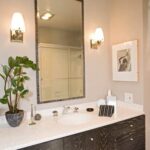Congratulations on the impending arrival of your baby. As you prepare for this exciting new chapter in your life, one important aspect to consider is creating a welcoming and nurturing home environment for your newborn.
The way you decorate and set up your home can have a significant impact on your baby’s emotional and physical well-being. In this article, we will explore why it is crucial to create a comforting space for your little one and how you can achieve that.
Science has shown that the environment in which babies grow and develop plays a crucial role in their overall development. Creating a welcoming home for your newborn not only makes them feel safe and loved but also promotes their cognitive and emotional development. A comfortable and inviting space can have a positive effect on their mood, sleep patterns, and ability to self-soothe. It provides them with a secure base from which they can explore the world around them.
The design choices you make for the nursery or designated baby area are essential in fostering this sense of comfort and security. Carefully selecting colors, choosing furniture that meets their needs, and incorporating stimulating elements can all contribute to creating an optimal environment for your baby’s growth. By paying attention to the details outlined in this article, you will be able to transform any space into a loving sanctuary where your child can thrive.
So let’s dive into the various aspects of decorating your home to welcome your baby with open arms. From planning the nursery to ensuring safety measures are in place, we will guide you through practical tips and design ideas that will help you create an inviting space that radiates love, care, and warmth for both you and your bundle of joy.
Planning the Nursery
When it comes to welcoming a new baby into your home, one of the most exciting and important tasks is planning the nursery. The nursery is not just a place for your little one to sleep, but also a space that promotes their growth, development, and overall well-being. In this section, we will discuss some key considerations and design tips to help you create the perfect nursery for your baby.
One of the first things to consider when planning the nursery is choosing the right room. Ideally, it should be a quiet and peaceful space away from high traffic areas in your home. This will help create a soothing environment for your baby’s sleep and minimize disturbances. Additionally, selecting a room with ample natural light can provide a warm and inviting atmosphere.
Next, it’s important to select a color scheme and theme that promotes calmness and stimulates development. Soft pastel colors like light blues, greens, or yellows are often favored for nurseries as they create a serene ambiance. Avoid using bold or bright colors that may overstimulate your baby. Incorporating nature-based themes such as animals or flowers can also be visually appealing and engaging for infants.
In terms of furniture and storage solutions, there are some essential items that every functional nursery should have. A crib is undoubtedly the centerpiece of any nursery, so choose one that meets safety standards and provides comfort for your little one. Make sure to invest in a quality mattress that supports healthy sleep posture as well.
| Item | Recommendation |
|---|---|
| Crib | Choose a crib that meets safety standards (JPMA certified), with adjustable mattress height settings. |
| Mattress | Select a firm and breathable mattress that fits snugly in the crib with no gaps. |
| Changing Table | Consider a changing table with storage shelves or drawers for easy diaper changing and organization. |
| Glider or Rocking Chair | Select a comfortable chair for feeding and cuddling your baby. Look for one with good back support and padded armrests. |
In addition to these furniture items, it is also essential to have sufficient storage solutions to keep the nursery organized. Baskets, shelves, and closet organizers can help maximize space and keep baby essentials like diapers, clothing, and toys neatly arranged.
By carefully considering these key considerations and design tips, you can create a nursery that not only looks beautiful but also provides a nurturing environment for your baby’s growth and development. Remember to focus on creating a peaceful atmosphere that promotes restful sleep, incorporates sensory elements for stimulation, and incorporates practical storage solutions for easy organization. With love and care, your nursery will become a haven of comfort for your little one.
Safety First
The safety of your baby is a top priority when preparing your home for their arrival. Babyproofing your home is essential to create a safe and secure environment where your little one can explore and play without the risk of accidents or injuries. Here are some key considerations and tips for babyproofing your home:
Identifying potential hazards in your home
- Start by conducting a thorough evaluation of every room in your house. Look out for sharp corners, exposed electrical outlets, dangling cords or curtains, unstable furniture, and any other potential dangers.
- Make sure all cleaning supplies, medications, and hazardous substances are stored securely out of reach.
- Be mindful of small objects that could pose a choking hazard and ensure they are kept away from curious hands.
Eliminating potential hazards
- Install safety gates at the top and bottom of stairs to prevent falls. Make sure these gates are securely fastened and cannot be pushed over or climbed by an adventurous toddler.
- Cover electrical outlets with outlet covers or use sliding plate covers that automatically close when not in use.
- Use corner protectors on sharp furniture edges to prevent bumps and bruises.
Tips for ensuring a safe environment
- Anchor heavy furniture like dressers or bookshelves to the wall to prevent tipping when your baby tries to climb on them.
- Keep window blind cords out of reach or opt for cordless blinds to avoid the risk of strangulation.
- Consider using door knob covers or cabinet locks to keep curious children away from potentially dangerous areas like the kitchen or bathroom.
By taking these steps to babyproof your home, you can have peace of mind knowing that your little one will be safe as they explore their surroundings. However, it’s important to remember that no amount of babyproofing can substitute parental supervision. Always keep a watchful eye on your child and be proactive in addressing new safety concerns as they arise.
Creating a Cozy Crib for Restful Sleep
Creating a comfortable and restful sleep environment for your baby is essential for their physical and emotional well-being. Selecting the right crib and mattress is an important first step in creating a cozy sleeping space. When choosing a crib, make sure it meets safety standards and has sturdy construction. Consider the mattress as well, ensuring it is firm and fits snugly within the crib.
In addition to selecting the right crib and mattress, choosing appropriate bedding is crucial. Opt for fitted sheets that cover the mattress tightly to prevent suffocation hazards. Avoid using pillows, blankets, or plush toys in the crib, as they can pose risks to your baby’s safety during sleep. Instead, use wearable blankets or sleep sacks to keep your baby warm without compromising their safety.
Establishing a bedtime routine can also contribute to a restful sleep environment for your little one. Consistency is key when it comes to establishing this routine. Choose soothing activities such as bath time or reading a bedtime story to help calm your baby before sleep. Creating a dim and peaceful atmosphere in the nursery can also signal to your baby that it’s time to wind down.
In addition to these factors, consider incorporating white noise or soft lullabies into the nursery environment to further promote restful sleep for your baby. This gentle background noise can drown out any sudden sounds that might disturb their sleep and help them feel secure.
By focusing on creating a comfortable and cozy sleeping space for your baby, you can ensure they get the quality rest they need for healthy development. Taking these steps will not only provide them with a safe environment but will also contribute to their overall well-being and happiness.
Decorative Touches
A baby’s nursery should not only be a functional space, but also one that nurtures and stimulates their senses. Incorporating decorative touches in the nursery can create a soothing and engaging environment for your little one. In this section, we will explore various ways to enhance the ambiance of the nursery and promote sensory development.
Incorporating Sensory Elements
To create a sensory-rich environment, consider incorporating elements that engage your baby’s senses. Soft lighting is important for creating a calming atmosphere. Opt for warm, dimmable lights that can mimic natural light and help soothe your baby during nighttime feedings or diaper changes. Additionally, you can use gentle music or white noise machines to create soothing sounds that promote relaxation.
Another way to stimulate your baby’s senses is by using mobiles. Hanging colorful mobiles above the crib not only adds visual interest but also encourages eye-tracking and stimulates cognitive development. Look for mobiles with a variety of shapes, textures, and contrasting colors to captivate your baby’s attention.
Wall Decals and Artwork
Wall decals are an excellent option for adding personality to the nursery without committing to permanent wallpaper. Choose decals that feature nature scenes, animals, or other visually stimulating designs. Wall decals not only add visual appeal but can also serve as educational tools as your baby grows older. Pointing out animals or objects on the decals can help develop their vocabulary and recognition skills.
Consider hanging artwork on the walls that reflects your baby’s interests or incorporates family photos. Babies love looking at faces, so hanging photos of loved ones can bring comfort and familiarity. Be sure to secure any artwork safely on the walls, far away from the reach of curious little fingers.
Personalized Touches
Adding personalized touches to the nursery adds warmth and sentimental value to the space. Consider displaying a special blanket or stuffed animal that holds sentimental value for your family. You can also incorporate artwork or quotes with meaningful messages, such as inspirational phrases or reminders of love and positivity.
Incorporating decorative touches in the nursery not only makes the space visually appealing but also contributes to your baby’s overall well-being. By engaging their senses and personalizing their environment, you create a nurturing and stimulating space where they can thrive and grow. Remember to choose decorations that are safe, age-appropriate, and easy to clean as you navigate this exciting journey of welcoming your baby into your home.
Practical Storage Solutions
When it comes to preparing your home for the arrival of a baby, practical storage solutions are essential to keep everything neat and organized. Babies come with a lot of stuff, from diapers and clothing to toys and accessories, so having an efficient storage system in place can make a big difference in maintaining order and reducing clutter. Here are some tips and ideas for creating practical storage solutions in your baby’s nursery:
- Utilize baskets: Baskets are a versatile and stylish option for organizing baby essentials. Use them to store items like diapers, wipes, burp cloths, and small toys. Opt for baskets with handles for easy transport and consider labeling them to make it even easier to find what you need.
- Install shelves: Shelves not only provide functional storage but also add visual interest to the nursery. Install shelves on the walls above the changing table or crib to keep items within reach. You can use them to display books, stuffed animals, or decorative items while still keeping things organized.
- Invest in closet organizers: A well-organized closet can be a game-changer when it comes to storing your baby’s clothes and accessories. Consider installing closet organizers with adjustable shelves and hanging rods to maximize space. Use bins or dividers to separate different sizes of clothing or categorize items by type.
- Think vertically: Don’t forget about vertical storage options such as wall-mounted hooks or hanging organizers. These can be used for hanging items like hats, bibs, or even small blankets. They take up minimal space while providing quick and easy access to frequently used items.
- Rotate toys: As your baby grows, they will accumulate more toys that need to be stored somewhere. To prevent the nursery from becoming overwhelming with toys, consider implementing a toy rotation system. Keep only a few toys accessible at a time while storing the rest in labeled bins or containers out of sight. This not only keeps the room tidy but also allows your baby to focus on playing with a smaller selection of toys.
By implementing practical storage solutions in your baby’s nursery, you can create an organized and clutter-free space that is both functional and visually appealing. Remember to regularly declutter and reassess your storage system as your baby grows to ensure it remains efficient. With a well-organized nursery, you can spend more time enjoying precious moments with your little one and less time searching for that pacifier or missing sock.
Comfortable and Functional Seating Areas for Feeding and Bonding
Feeding and bonding with your baby is a special and important time for both you and your little one. Creating a comfortable and functional seating area in your home can enhance this experience and make it more enjoyable for both parent and child.
When choosing a chair or glider for feeding, it’s essential to prioritize comfort. Look for a chair with adequate padding and lumbar support to provide proper back support during long nursing sessions. Consider options that allow you to recline or rock gently, as these movements can help soothe your baby while feeding. Additionally, opt for a chair with armrests that are at the right height for comfortable positioning during breastfeeding or bottle-feeding.
It’s also important to design a cozy nursing corner that is well-equipped with essential supplies within reach. Keep items such as burp cloths, bibs, breast pads, bottles, and extra blankets easily accessible so you don’t have to leave your seat during feeding time. Consider installing shelves or using storage baskets nearby to keep everything organized and within arm’s reach.
Creating a calm and relaxing ambiance in the feeding area can also contribute to bonding between parent and baby. Soft lighting, such as a dimmable lamp or night light, can create a soothing atmosphere during nighttime feeds. Some parents find playing gentle music or white noise helpful in calming their little ones while they feed. Experiment with different elements to see what works best for you and your baby.
In order to provide the utmost comfort during feeding sessions, ensure that your seating area is set up in a quiet part of the house where there are minimal distractions. This will help create an environment conducive to bonding without interruptions.
Overall, having comfortable and functional seating areas dedicated to feeding and bonding in your home can positively impact both you and your baby’s experience. Taking the time to carefully design this space will promote relaxation, comfort, and connection between parent and child.
| Seating Features | Considerations |
|---|---|
| Comfortable Padding and Lumbar Support | Look for a chair that provides adequate support for your back during long feeding sessions. |
| Reclining or Rocking Functionality | Gentle movements can help soothe your baby while feeding. |
| Armrests at the Right Height | The right height will ensure comfortable positioning during breastfeeding or bottle-feeding. |
| Essential Supplies Within Reach | Keep items like burp cloths, bibs, bottles, and blankets nearby for easy access during feedings. |
| Calm and Relaxing Ambiance | Create a soothing atmosphere with soft lighting, gentle music, or white noise. |
Adapting the Home for Baby’s Growing Needs
Adjusting the Overall Home Layout
As your baby grows, it becomes necessary to make adjustments to the overall layout of your home in order to accommodate their changing needs. This includes creating safe spaces for crawling and exploring, as well as designating areas for play and learning.
One important step in adapting your home is ensuring that it is free from hazards such as sharp corners, unstable furniture, and objects that could potentially be harmful to your baby. It’s essential to assess each room with a critical eye, considering potential risks and making any necessary changes.
Incorporating Play Areas and Safe Zones
Creating dedicated play areas throughout your home allows your baby to explore and develop new skills in a safe environment. Consider setting up a small area with soft flooring or rugs in the living room or a spare bedroom where your baby can crawl, roll, and practice tummy time. You can also use gates or playpens to create safe zones so that you can be sure your little one is always within sight while playing.
Additionally, consider incorporating toys and age-appropriate activities into these play areas to stimulate your baby’s growth and development. Choose toys that encourage motor skills, problem-solving, and sensory exploration. As they grow older, you may want to add items like climbing structures or simple puzzles to further engage their curiosity and creativity.
Tips for Making the Transition
One of the biggest transitions you’ll face as a parent is moving from a nursery designed for an infant into a toddler-friendly space. As your child begins walking, climbing, and exploring more independently, there are several steps you can take to ensure their safety while still encouraging their natural curiosity.
Start by securely anchoring furniture such as bookshelves or TV stands to the wall to prevent tipping accidents. Install safety latches on drawers or cabinets that contain potentially dangerous items like cleaning supplies or medications. Consider adding corner guards or padding to sharp edges throughout the home, particularly at toddler eye level. Finally, make sure that electrical outlets are covered and cords are out of reach to prevent accidents.
As your child grows, you can continue adapting your home to meet their changing needs. Create a designated study area for older children with a desk or table and suitable seating. Ensure that their bedroom is comfortable and supports healthy sleep habits, including providing a suitable mattress and maintaining a calming atmosphere.
By adjusting the layout of your home, creating safe play areas, and making age-appropriate changes as your baby grows, you can ensure that your home remains a nurturing environment for years to come. Adapting your space will not only support your baby’s development and foster independence but also provide them with a loving place to explore, learn, and grow.
Conclusion
In conclusion, creating a welcoming and nurturing environment for your baby is of utmost importance. The home environment plays a significant role in the emotional and physical well-being of your little one. By planning the nursery carefully and considering key factors such as color scheme, furniture, and storage solutions, you can create a space that promotes calmness and stimulates development.
Ensuring the safety of your baby is another crucial aspect of preparing your home. Babyproofing includes identifying potential hazards and taking necessary precautions such as installing safety gates, outlet covers, and corner protectors. By making these adjustments, you can establish a safe and secure environment for your baby to explore as they grow.
Creating a cozy crib for restful sleep is essential for both the baby’s well-being and yours too. Selecting a suitable crib and mattress, choosing bedding that meets safety standards, and establishing a bedtime routine can all contribute to better sleep quality. Incorporating decorative touches such as soft lighting, gentle music, mobiles, wall decals, or personalized touches like family photos also enhance the nurturing atmosphere in the nursery.
Practical storage solutions are crucial in keeping everything neat and organized in the nursery. Baskets, shelves, closet organizers can all help maximize space while maintaining an organized environment as your baby grows. Additionally, comfortable seating areas designed for feeding and bonding provide intimate spaces where parents can enjoy precious moments with their newborn.
Lastly, as your baby continues to grow, it’s important to adapt your home accordingly. This may involve adjusting the overall layout to accommodate play areas or safe zones for crawling and exploring. Making this transition from nursery to a toddler-friendly space allows for continued growth and development in a stimulating environment.
Above all else, remember to approach decorating and adapting your home with love and care in preparation for the arrival of your baby. Enjoy this special time by creating a space that nurtures both you and your little one while forging deep bonds that will last a lifetime.
Frequently Asked Questions
How do you welcome a newborn baby at home with decorations?
When welcoming a newborn baby at home with decorations, it is important to create a warm and inviting atmosphere. One popular way to decorate is by placing balloons and banners in the entryway or living room to announce the arrival of the little one. You can also use wall decals or custom-made signs with the baby’s name to add a personalized touch.
Adding soft and cozy textiles such as blankets, pillows, and stuffed animals can create a comforting environment for both parents and baby. Lastly, consider incorporating baby-themed artwork or prints on the walls, showcasing adorable illustrations or photographs that celebrate this special milestone.
How to decorate for baby coming home?
Decorating for a baby coming home involves creating a serene space that is safe and comfortable for both the newborn and their parents. Begin by choosing a color scheme that reflects tranquility and joy, such as pastel shades or soft neutrals. Hang curtains or blinds that allow natural light to filter through while maintaining privacy.
Warm lighting fixtures like table lamps or string lights can also add a cozy glow to the room. Consider adding functional elements such as a diaper changing station stocked with essentials, storage solutions for clothing and supplies, and a comfortable rocking chair or glider for feeding sessions. Don’t forget about adding personal touches like framed ultrasound pictures or handcrafted items gifted by loved ones.
How to decorate home to welcome someone?
To decorate your home to welcome someone, it is crucial to consider their preferences and interests while also keeping in mind the occasion they are being welcomed for. Start by creating an inviting entryway – place fresh flowers in vases, hang wreaths on the door, or lay down a small doormat with their initials or favorite design. Make sure there are enough seating options available to accommodate guests comfortably while allowing for easy conversation.
Enhance your living spaces with decorative accents such as floor plants, decorative cushions, cozy throws, or even scented candles tailored to their favored aromas. Displaying photographs of memorable moments shared together can evoke a sense of nostalgia and make them feel appreciated. Ultimately, the goal is to create an ambience that reflects their presence and makes them feel truly welcomed into your home.

I’m thrilled to be your companion on this exciting journey through the world of home decor and design. With a passion for turning houses into homes and a keen eye for the finer details, I’m here to help you transform your living spaces into beautiful, functional, and meaningful havens.





